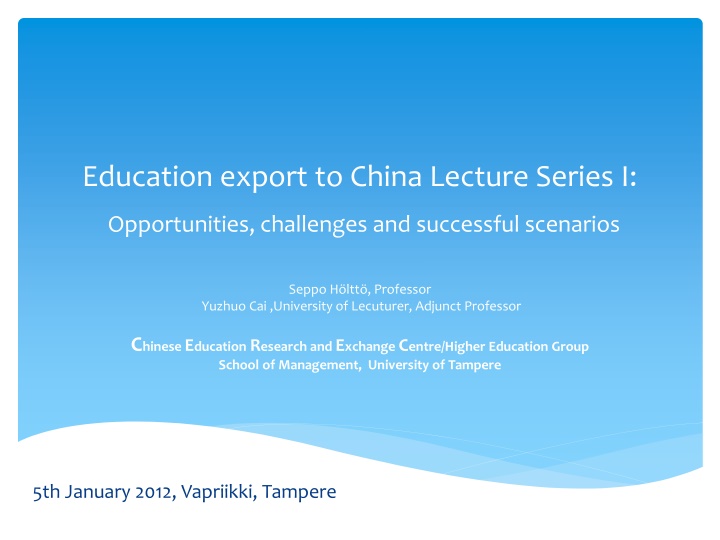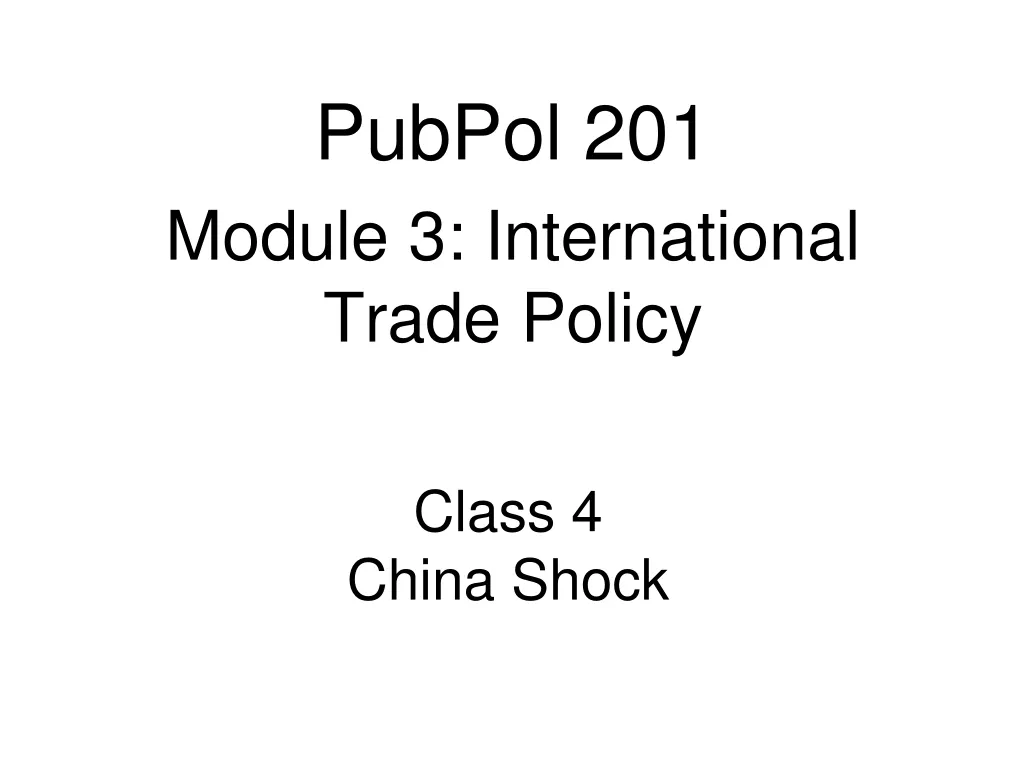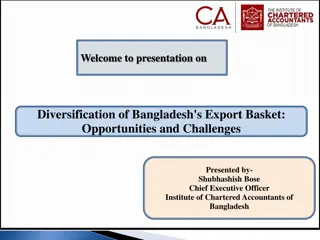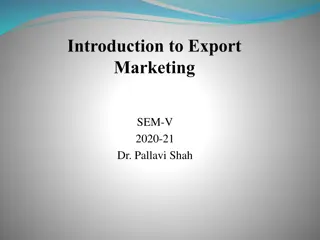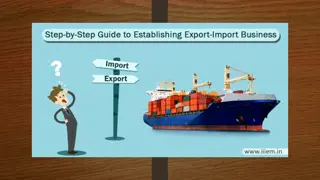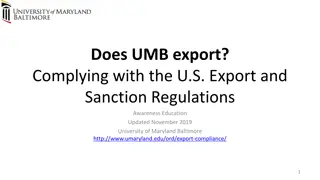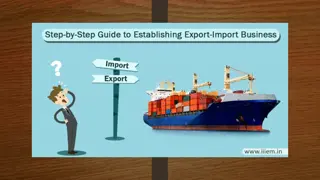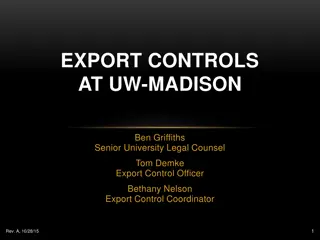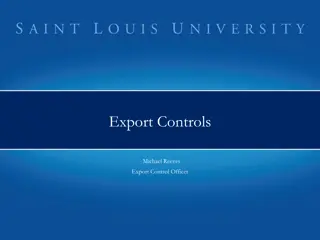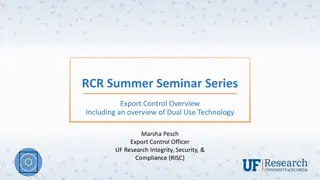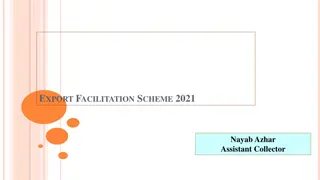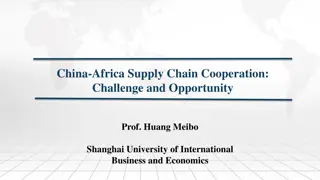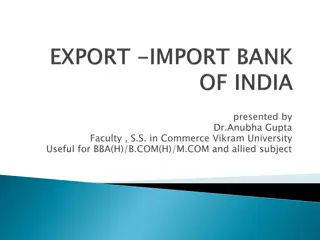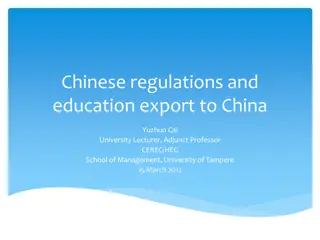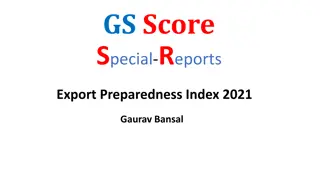Education Export to China: Opportunities and Challenges Lecture Summary
In this lecture series, education export to China was discussed, focusing on the opportunities, challenges, successful scenarios, and potential risks. The evolution of internationalization of education in Finland, with China as a key export destination, was also explored. Various models of internationalization and drivers for change were highlighted, emphasizing the emergence of a knowledge-based society and global trends. The move towards education export in Finland, starting in the higher education sector and extending to all sectors, was detailed along with related strategies and initiatives.
Download Presentation

Please find below an Image/Link to download the presentation.
The content on the website is provided AS IS for your information and personal use only. It may not be sold, licensed, or shared on other websites without obtaining consent from the author.If you encounter any issues during the download, it is possible that the publisher has removed the file from their server.
You are allowed to download the files provided on this website for personal or commercial use, subject to the condition that they are used lawfully. All files are the property of their respective owners.
The content on the website is provided AS IS for your information and personal use only. It may not be sold, licensed, or shared on other websites without obtaining consent from the author.
E N D
Presentation Transcript
Education export to China Lecture Series I: Opportunities, challenges and successful scenarios Seppo H ltt , Professor Yuzhuo Cai ,University of Lecuturer, Adjunct Professor Chinese Education Research and Exchange Centre/Higher Education Group School of Management, University of Tampere 5th January 2012, Vapriikki, Tampere
Main topics Changes of internationalisation of education in Finland China as a prioritised export destination Opportunities Challenges Successful scenarios & potential risks Future topics
Changes of internationalisation of education in Finland
Models of internationalisation of education in Finland 1) traditional individual based mobility, 2) internationalisation based on bilateral institutional agreements, 3) programme based internationalisation 4) internationalisation based on institutional and disciplinary networks 5) market oriented internationalisation.
Drivers for change Emergence of knowledge based society Growing importance of knowledge in production (as a resource and product) Globalisation National and supra-national policies Internationalisation Importance of HE in other national and regional policies (national competitiveness) Internationalisation of HE and universities
A move towards education export Initiated in Higher education sector Amendments to both the Universities Act (1997/645) and the Polytechnics Act (2003/351) made to order education Universities Act (2009) tuition fee programmes Selected Master programmes Made to order education Strategy for the Internationalisation of Higher Education Institutions (2009-2015)
A move towards education export Extend to all sectors of Finnish education Education Export Strategy (2009) Future Learning Finland (2010) Funded by three Ministries Coordinated by Finpro
Need for institutional capacity building Linked to the University Reform (New legal status of universities) International Master programmes National and European (Erasmus Mundus) Professional continuing education programmes Reforms of international administration (new models of internationalisation)
QUESTIONS What we mean by educational markets? Which kinds of markets we want to operate in? Which kinds of products we want to offer to the markets? Which kinds of capacity we need to operate in the selected segments of markets?
China as an prioritised export destination
China Action Plan (MOF, 2010) China is considered as an important international actor and as a partner to Finland and EU Outside EU, China is the second largest trader partner of Finland after Russia 8 Billion Euros Finnish investment in China 340 Finnish offices, subsidiaries and joint-venture in China
Asia Action Programme (MOE, 2006) Development of expertise on Asia and co-operation with Asian countries are priorities of internationalisation. Many rapidly developing Asian countries offer great potential and it is important for Finnish higher education institutions, research institutions, the cultural field and other parties to aim to take advantage of this potential in their international co-operation as well. Regionally, operations are specifically targeted at countries in East and South Asia, where the attraction of China, Japan, South Korea and India is internationally strong.
Strategies for Internationalisation (MOE, 2009) The rapid economic growth in populous fast developing countries, such as China and India, and their engagement with the global economy affect the direction that internationalisation takes. China and many other rapidly growing economies are increasing their investment in higher education, research and innovation. The relative weight of Finland as a higher education and science country is diminishing.
What opportunities? Opportunities in terms of increasing market demand Opportunities in terms of policy changes in China Opportunities in terms of Finland s international image Opportunities in terms of benefits for Finnish business sector
Chinese degree students in Finland 2500 2000 1500 1000 500 0 2000 2001 2002 2003 2004 2005 2006 2007 2008 2009 2010
Biggest student source country China is the largest student source country, accounting for 18.5% of all students -studying abroad in the OECD area (OECD 2010) Chinese students represent the largest international student cohort in Finland (CIMO 2010)
Foreign students in Finland in 2010 2500 2000 1500 1000 500 0
Big potential for revenue Only 0,81% of Chinese students pursuing studies abroad come to Finland (2095 against 285,000) In addition to young students, there is a growing demand for training adults (officials, managers, professionals)
The principles set by the Central Communist Party Committee in 1992 To support students and scholars studying abroad, To encourage them to return to China after their completion of studies, and To guarantee them the freedom of coming and going.
Chinas joining WTO Commitment to GATS: four models New regulations on foreign educational provision in China
Model 1 & 2 Mode 1: Cross-border supply Refers to the provision of distance educational courses and services. No commitment to cross-border supply in terms of either market access or national treatment. Mode 2: Consumption abroad Refers to citizens of one country studying in another country. For this mode, China has imposed no limitations either on market access or national treatment.
Model 3 & 4 Mode 3: Commercial presence Refers primarily to the educational institutions from one country in another country to set up schools and other educational institutions that are engaged in education and related services. According to China s commitment, foreign education institutions are not allowed to independently set up branches and other organisations. Mode 4: Presence of natural persons Refers primarily to the citizens of one country in another country who are engaged in professional teaching and training. There is a limitation on market access with respect to the movement of people: qualified foreign individuals may enter China to provide education services when invited or employed by Chinese education institutions.
Domestic legislation the Regulations on Chinese-foreign Cooperation in Running Schools issued by the State Council in 2003 CFCRS: the activities of the cooperation between foreign educational institutions and Chinese educational institutions in establishing educational institutions within the territory of China to provide education service mainly to Chinese citizens
Image of Finland Success of Finland in PISA Chinese do look Finland as a good example of basic education and try to learn Finnish lessons. Also good image in other areas, such as clean technology, ICT, public administration, etc. More Chinese officials and professionals trend to take training courses in Finland.
Existing Finnish companies in China 300 companies 30,000 employees Need qualified labour forces
Opportunities for business sector Training Chinese learners in Finland as a direct promotion of the local tourist industry. Promoting Finnish business through educating and influencing Chinese governmental officers and company leaders who are in Finnish training programmes. Building partnership between Finnish Companies and Chinese Universities through Finnish HEIs. Educating Chinese talents for Finnish companies business operations in China and even the labour market in Finland.
What challenges? Challenges at home Not ready for education export Lack of clear strategy in implementation Challenges in the market place Image of Finland is not well-perceived in China A difficult market
General review by MOE (2007) In education, research and culture, Finland has a wide range of relations with Japanese, Chinese, India and Korean organisations. However, seen as a whole they are fairly dispersed. Relations with Asian countries seems to be lacking in coordination both at home and among units operating in Asian countries. As the countries in question are extremely large in comparison with Finland, the presence and contacts of one single Finnish organisation there will not achieve the desired effect. Perhaps the most critical shortcoming is, however, that the aims of different organisations with regard to cooperation with Asian countries often seem to be rather unfocused.
Readiness of education export Traditional academic values Lack of experience on education export Lack of knowledge on targeting market Lack of commitment Lack of investment (and even the financial framework for investment in education export) Lack of coordination Restrictions by Finnish legislation
Objective of internationalisation strategy The number of international degree students will be considerably increased The international education will be developed as an export industry (MOE, 2009)
Dilemma 1 On the one hand, charging tuition fees from some international students would not be likely to generate much additional revenue until international students made up a substantial proportion of the total student population . On the other hand, as the majority of current international students chose to study in Finland because of its free education, the international student number may drop after tuition fees are introduced
Dilemma 2 Full-cost fees was introduced in 1980 in UK Financial pressure drive British HEIs to go out into the world of market In Finland, the Government does not want to give much pressure to HEIs, but expects the HEIs are motived to do education export
Dilemma 3 The Government expects the education export can be the second NOKIA to boost the economy of Finland, but has not considered or stressed the importance of investment.
Less attention to key issues What should be expected from international students? How much should be charged for tuition fees? Why do students study in a host country? What type of education export should be the priority?
Image of Finland In general, Finland (higher education in particular) is not well-known in China
Quality bring success? Yes by theory. But in practice quality can hardly be measured What affect (Chinese) students choice in pursuing foreign education? University ranking/reputation Employment prospect
Difficult in entry the opportunities are there, but the entry costs will be high (Adams, 2007, p. 414) Institutional cooperation (in China) is not established over night it requires a substantial amount of planning, exchange and commitment . (NESO, 2010, p. 37):
Difficult in networking and trust building Reflection from Finnish business operations in China Mainly doing business with foreigners though being located in China Educationalists have less knowledge and experience in doing business in China
Difficult in understanding What written by policy documents vs. what happened in practice The languages need to be interpreted not only linguistically but also culturally Difficult to access to statistics Diversity and variety
Difficult in operation How to maintain network or relationship (Guanxi) Trust issue (different way of building trust) Finns people normally build transaction first and, it successful, a relationship/trust will ensure. Chinese believe that perspective partners should build a relationship/trust first, if successful, transactions or effective activities will follow. Lack of competent stuff to work in negotiation and running business
Conflicts in bureaucratic procedures Planning China: fast decision and expect quick response, short term plan, plan is abstract Finland: slow decision and take a long time to respond, long term plan, plan is concrete Contract cost based on per person cost based on total programme
Models of education export Synergy between industry education export and industry education export Focus on a few areas which Finland has special expertise and reputation Academic expertise Development expertise Develop offshore education in cooperation with local partners in China Traditional model of student studying abroad will remain but the emphasis tend to attracting most gifted students.
Marketing Efforts towards cooperation and one Finnish brand More investment on product development and marketing
Capacity building More studies on education export and targeting market (identifying future tendencies) Utilise experts, alumni and local partners Partnership with Chinese universities and schools Effective national coordination on education export University, UAS, School cooperation in Finland
Poor quality programmes may ruin the reputation of the whole Finnish education Rush to education export with irrelevant curricula to local market needs Find the wrong (niche) markets Find the wrong partners Neglect experts role
Future lectures Chinese education reforms and trends 13-15 8th Feb Relevant policies and reforms in China and implications for foreign educational providers 13-15 15th March Marketing and branding Finnish education in China 13-15 18th April Places will be in the University of Tampere premise
